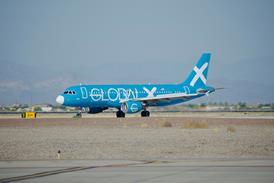Guy Norris/LOS ANGELES
The US Air Force has warned Congress that failure to fund the Lockheed Martin/Boeing F-22 Raptor in the fiscal year 2000 defence budget will have a major impact on the Joint Strike Fighter (JSF) project.
Maj Gen Claude Bolton, USAF programme executive, fighter and bomber programmes, says a funding cut for the F-22 will delay Raptor engineering, manufacturing and development by one year, and production by five years. It will also increase overall costs by between $6 billion and $6.5 billion.
"We have been working on a very fine line for the past few years to stay under the cost cap. If this [funding cut] happens, I will have no choice other than to terminate contracts and restructure the programme," he says.
Bolton says the knock-on effect of cancelling the contracts with Lockheed Martin and Pratt & Whitney, in particular, "will have a huge impact on the JSF". Developments in stealth, avionics and sustainability being pioneered by the F-22 "will all have to be picked up and paid for by the JSF". Bolton also warns that reliance on upgrades of the Boeing F-15 will not be sufficient to maintain air superiority. "The F-15 cannot be made any stealthier and will not be able to hack it," he adds.
On 16 July, a key Congressional committee voted to block FY2000 funding for the first six production aircraft, sending a shiver of apprehension through the USAF, even though other committees have voiced support.
Five days later the F-22 test aircraft, 4001, demonstrated supercruise capability, or sustained speeds of more than Mach 1.5 without afterburner, in tests at Edwards AFB, California, and this key milestone was seized upon by the USAF as an opportunity to rally support for the air superiority fighter.
The USAF denies that the supercruise demonstration was deliberately timed to provide good publicity for the F-22, but Bolton admits that the news "will help build a case for the aircraft". Col Clyde Moore, Combined Test Force commander at Edwards AFB, says the supercruise exercise was part of "a natural progression as we extend the envelope" and was initially planned to be demonstrated in July or August.
Moore, who piloted Raptor 01 for the test flight, says: "The problem was not sustaining supercruise, but keeping it from flying faster." The M1.5 run was maintained for 3min in straight and level flight at 41,000ft (12,500m). The P&W F119 engines were set at "well below military power in sustaining M1.5. They were below what I anticipated and even what the engineers had anticipated," he says, adding that the next target is M1.6.
The formal accomplishment of supercruise also marks the achievement of three of the five major tasks set by the Defense Acquisition Board for the F-22 task force to achieve by the end of this year. Two targets already reached include envelope expansion to 55,000ft and the opening of side and main weapons bays at supersonic speeds.
Two further targets include high angle-of-attack flight to demonstrate the use of thrust vectoring beyond normal maximum coefficient of lift, and expansion of the high speed envelope. "We plan to achieve all that by early September," says Moore.
Source: Flight International























